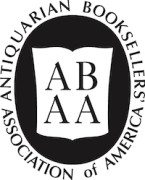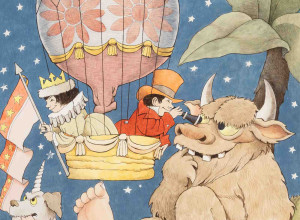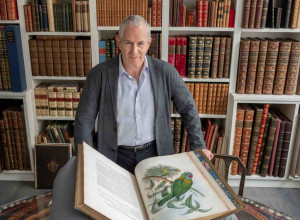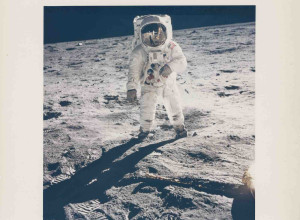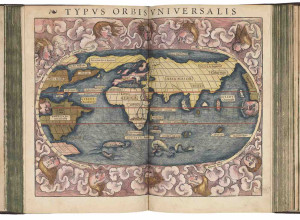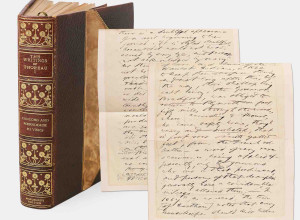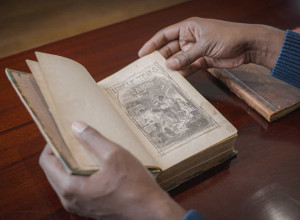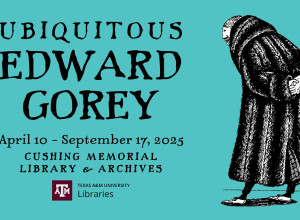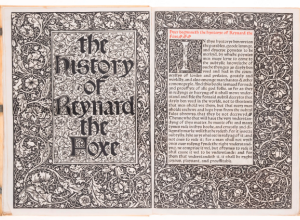Bright Young Librarians: Jesse Erickson
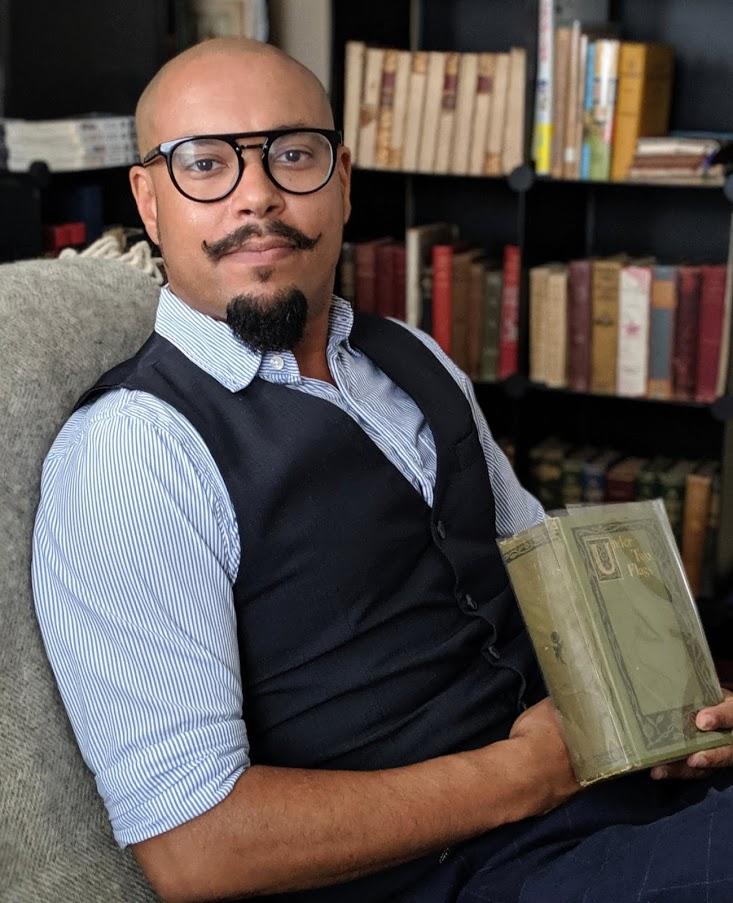
Our Bright Young Librarians series continues today with Jesse Erickson of the University of Delaware:
What is your role at your institution?
I have a somewhat unique arrangement at the University of Delaware that allows me to work in three different interconnected roles. I am currently the coordinator of special collections and digital humanities at the University of Delaware Library, Museums, and Press; I am an assistant professor in the Department of English; and, I am also the associate director of the Interdisciplinary Humanities Research Center (IHRC). Although not without its challenges, I find the arrangement to be intellectually stimulating. I am afforded the opportunity to teach full-credit, semester-long courses around specific archival and rare book collections while still maintaining all the duties of a rare book librarian including reference, collection development, and curatorial work. Additionally, my role at the IHRC challenges me to help come up with new strategies for supporting interdisciplinary partnerships and collaborations among different departments on campus as well as local museums and community organizations. It is really the best of all worlds.
How did you get started in special collections?
I often hear people share that they got their start in special collections by chance, either from library experience as a student worker, or something else along those lines. My path to special collections, however, was somewhat uncommon in that it was something that I set out to achieve upon returning to school in my mid-twenties at the undergraduate level. Back then, a little over thirteen years ago now, I was going through a very rough period in my life. My mother unexpectedly passed away at the young age of forty-nine, and I had been struggling to emerge from living a life of transience—sleeping outside, on friend’s couches, living in hostels and hotels, washing dishes to get by, that sort of thing. After learning about the then recent opening of the California Rare Book School, my path became clear to me. Regardless of any obstacles that would come my way, I was determined to land a career in rare books. I quit the dishwashing jobs I had been working at to survive, and by that combination of grit and providence so intrinsic to the American spirit, I landed my first library position as a messenger clerk at the Los Angeles Public Library. Before the California Rare Book School brought the field of rare books to my attention, I wasn’t even aware that there was a specialized field in librarianship that involved this kind of work. I had always loved the world of books and libraries; and growing up, my mother would take me to the Huntington Library and Botanical Gardens so often that we even had a season pass one year when I was in my teens. Suddenly, I realized that being a rare book librarian would mean that I could work in place like that, the library of my dreams. So, I set everything I had in me toward achieving that goal. The whole idea seemed so remote as to be in the realm of fantasy. And there were so many subtle messages coming at me to dissuade a person of my background from pursuing this field. Tenacity and determination, however, would not allow me to give up on the dream. Here I am, all these years later, doing what I set out to do. And none of this would have been possible without the mentorship of so many others who supported me along the way.
Where did you earn your MLS/advanced degree?
I earned both my MLIS and my PhD in Information Studies from the Graduate School of Education and Information Studies at the University of California, Los Angeles, where I had the honor of being advised by Dr. Johanna Drucker.
Favorite rare book / ephemera that you've handled?
Given that the University of Delaware Library, Museums, and Press houses the renowned Mark Samuels Lasner Collection of late Victorian literature, I have had the chance to handle my all-time favorite novel, Ouida’s Folle-Farine (1871), inscribed by the author to her lawyer James Anderson Rose, Esq. I’ll confess that the experience brought me to tears of elation. Even so, I would say that the book in our collection with the most personal resonance would be Arthur Alfonso Schomburg and Charles F. Heartman’s A Bibliographical Checklist of American Negro Poetry (1916), which includes Schomburg’s inscription to teacher, writer, and activist, Alice Ruth Moore Dunbar-Nelson (1875-1935). The many connections embodied in this book dealing with Black history, bibliography, book collecting, and the book trade are an encapsulation of everything my journey in this field represents.
What do you personally collect?
I have been collecting exclusively in a single author for around five or six years now. I started collecting works from Victorian period author Ouida (1839-1908) after I fell in love with her novels in the summer of 2013. Since that time, I have become one of the biggest fans of her work alive today. I binge read her twenty-six three-decker novels, back-to-back, over the course of three years. To date, I have read all fifty-two of her published books, most of her published essays, and at least two unpublished manuscript essays. One thing about my collection that makes it unusual in the world of antiquarian book collecting is that I place a great deal of value on traces of ownership, readership, and use. At her peak, Ouida was a popular celebrity and bestselling author; so, in my eyes, if a copy is in poor condition, damaged, with tons of annotation, it is much more reflective of her circulation history than a crisp, unread copy in fine condition would be. Other collectors might think this is crazy, but I’ve never had the means to go after extremely expensive editions in the first place, so there is no point in trying to compete at that level. Nevertheless, even without a great deal of resources at my disposal, I have managed to acquire some real gems. No Ouida collection would be complete without the 1906 Roycrofters edition of A Dog of Flanders (1872). I managed to acquire a copy of her earliest piece of published writing, “Dashwood’s Drag,” which was featured in Volume XLV of Bentley’s Miscellany (1859). I prize the American first editions from J. B. Lippincott & Co. most. My collection includes thirteen of these, as well as a special illustrated Lippincott edition of Under Two Flags (1867) with a letter from the author to the North American Review tipped in. My collection also includes an American first edition of Signa (1875) signed by Jack London’s daughter, Bess “Becky” London, which is significant because Jack London cited reading Ouida’s Signa as one of his earliest inspirations to pursue a career as a novelist. And, beyond just books, I possess an interesting array of Ouida-related periodicals and ephemera. I have an Ogden’s Guinea Gold cigarette card featuring one of the few photographic images taken of the author during her lifetime. I have the September 1897 issue of Cosmopolitan magazine that includes an article she wrote about fashion. And I own an animation production cel from the 1997 Japanese animated adaptation of A Dog of Flanders. Whether it’s getting something truly special for a great deal, or watching something that has been on the market slip past me before I had the chance to buy it, the ups and downs of collecting Ouida has been one of the greatest joys of my life.
What do you like to do outside of work?
I tend to take on a lot of projects in my working life, so getting free time outside of work is something of a challenge. I most enjoy having the chance to spend time with my family. My son and daughter are so much fun. We go to a lot of town carnivals in the summer and hayrides and train rides in the fall. Even when the weather is bad, we can still have a good time just playing around at home. My wife and I are both into contemporary hip hop and R&B, so we’re always keeping up with the latest artists and discussing the newest music. There’s pleasure reading, of course, especially when it’s something by Ouida; but I also have several interests and hobbies that would fall into the category of a living a “Neo-Victorian” lifestyle. For example, I’ll enjoy a relaxing cup of loose-leaf tea, the occasional cigar and bourbon-based cocktail, old-fashioned grooming with a straight razor, arranging flowers, scrapbooking, and other activities that were popular in the nineteenth century.
What excites you about special collections librarianship?
Virtually everything about this field excites me! Since I am living out my dreams, I never take this blessing for granted. More than that, this is really such an exciting time to be working in special collections. I may sound like an optimist, but in my eyes, we are at the threshold of so much positive change. I see many possibilities for new directions, and it is wonderful to have a seat at the table and be a part of that process. Whether it is working to be a more inclusive field or finding new ways to support digital scholarship, primary source literacy, and interdisciplinarity, there are so many opportunities for this field to work better for the benefit of all.
Thoughts on the future of special collections librarianship?
What a question! I could go on and on about this one, but I will instead direct those readers who care most about these issues to keep an eye on my published scholarship and public lectures moving forward because I devote a great deal of attention to this subject. I’ll just say that we are still only at the very beginning stages of creating the conditions for a more diverse and inclusive culture in our field. There is so much work that needs to be done on that front. Furthermore, I am excited by shifts in our relationship to research and pedagogy that I believe will fundamentally change the ways in which we operate at every level. I am interested in the integration of everything from co-working office environments and special collections makerspaces to virtual reality reading rooms for digital collections and mobile pop-up exhibitions. The possibilities feel limitless the more we can expand our vision to entertain new and innovative ideas.
Any unusual or interesting collection at your library you'd like to draw our attention to?
The richness of the Library’s collections was one of the many reasons that I was so eager to work at the University of Delaware. I am especially impressed with the scrapbook and ephemera collections and those covering book and printing history. However, I’ll use this opportunity to call attention to the Library’s marvelous collections of paper samples and watermarks. In addition to collections from such papermakers and scholars as Thomas Gravell, Dard Hunter, and Frank Tober, these diverse holdings include sample books of traditional Japanese and Korean paper.
Any upcoming exhibitions at your library?
We have two truly amazing exhibits that recently opened in our Library’s gallery space. The first is Flowers of Freedom, an exhibit that I curated in commemoration of 1619. Focusing on the literary and scholarly accomplishments of African Americans post-emancipation, the exhibit features works by everyone from Irvine Garland Penn to Alice Dunbar-Nelson. Currently, our main gallery exhibition is From Thought to Print, a major exhibition curated by Rebecca Johnson Melvin, which highlights the complexities of the writing process from typescript to publishing to the criticism that follows. The exhibit includes samples from J. D. Salinger, Paul Bowles, Emily Coleman, Ishmael Reed, Tennessee Williams, and several other important writers.





